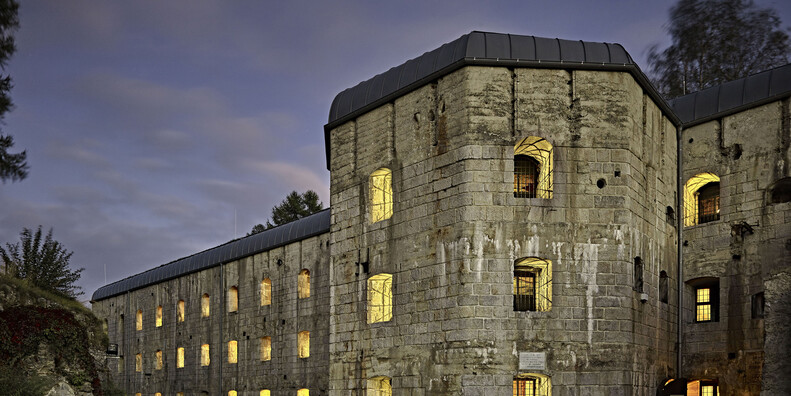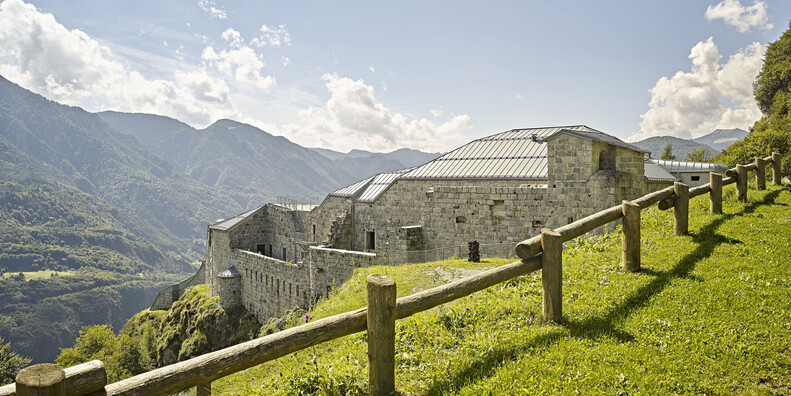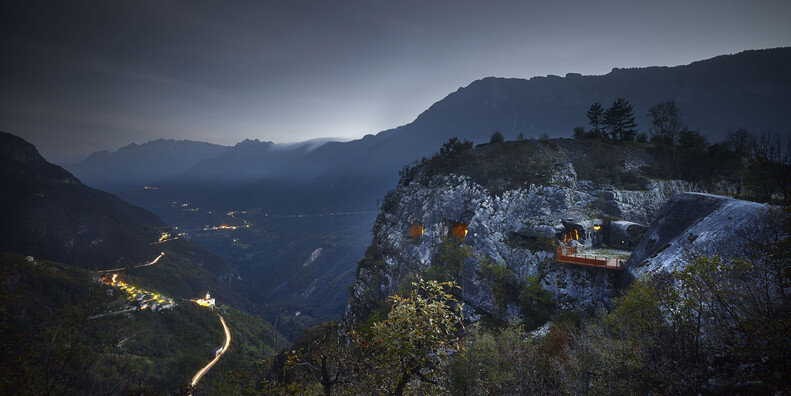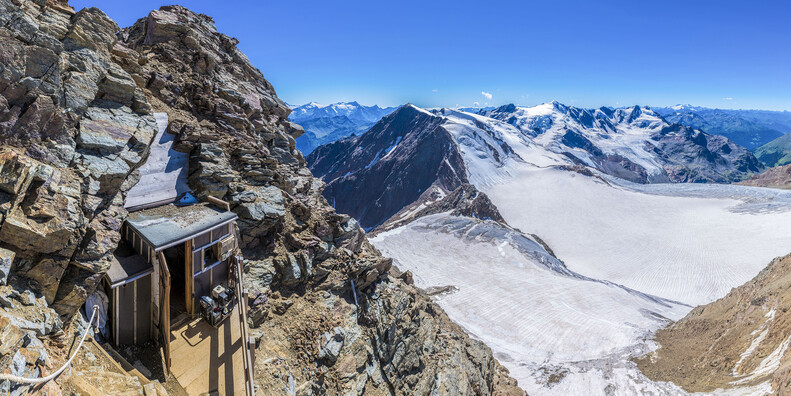FROM THE MEMORIES OF WAR, A REMINDER OF PEACE
Twenty fortresses, 19 museums dedicated to the Great War and hundreds of kilometres of mule tracks and entrenchments: an extraordinary historical heritage can be visited in Trentino, above all as a valuable reminder not to forget and to reaffirm the importance of peace
More than a hundred years have passed since the end of the First World War, an event that changed the history of Europe and indelibly marked the history of Trentino, which was involved right from 1914 as a province of the Austro-Hungarian Empire.
Between 1915 and 1918, this borderland was a battlefield – a long front that crossed valleys, mountains and Alpine peaks – and the stage for a constant challenge with the natural elements, even before confronting the enemy.
Trentino has reworked this dramatic period in history, becoming a dynamic laboratory of coexistence and dialogue, but without ever renouncing its duty of remembrance. With its network of 19 museums, 20 Austro-Hungarian forts, kilometres of trenches, communication trenches, tunnels and other feats of military engineering that tell the story of a century ago with a sense of immediacy, it can now be considered a vast "Memorial Park".
The Path of Peace
The Path of Peace, a route of over 520 km, connects the places and memories of the Great War on the Trentino front, from the Tonale Pass to the Marmolada. The entire route takes about a month to walk, but hikers can do single-day stages or treks of a few days, stopping at one of the many mountain huts along the way, choosing between low-altitude and high-altitude routes. Most of the sections of this route can also be covered on a mountain bike.
From the Tonale Pass, through the sites of the White War, you descend towards the Valle del Chiese and the Riva del Garda area with the nearby Monte Altissimo. You then reach Rovereto to visit its places of remembrance: the Museo della Guerra (War Museum), the Campana dei caduti (Bell of the Fallen) and the Sacrario di Castel Dante (Castel Dante War Memorial). Climbing up the Vallarsa, you reach the Pasubio Group, the Folgaria, Lavarone and Luserna Plateaux and then the Lagorai Group. The final stages run through the most breathtaking and historically important Dolomite scenery: Passo Rolle, Paneveggio, Passo San Pellegrino, Cresta di Costabella and Val Contrin. After passing the Forcella Marmolada, the Path of Peace ends at the Passo Fedaia.
The Circuit of the Forts
Along the Path of Peace there are also around 20 Austro-Hungarian fortresses that now form part of the cultural and geographical landscape of this land and bring the Circuit of Forts of Trentino to life. Their imposing presence testifies to the role played by Trentino in the conflict, while the architectural variety and the different types of construction and materials used highlight the transition from 19th-century military art to modern art, based on new and increasingly powerful firearms.
The best-preserved fortifications have for some years been the focus of an architectural recovery and restoration project by the Architectural Heritage Department at the Autonomous Province of Trento’s Superintendency for Cultural Heritage. These are the most recent reopenings.
A few kilometres from Rovereto, in Vallarsa, is Forte Pozzacchio, which is entirely carved into the rock of the mountain. In Valsugana, in Levico Terme, located on a hill overlooking the lake, stands the Forte delle Benne, while in the Valle del Chiese, in western Trentino, you can visit Forte Corno, inside the fortifications of Lardaro. The Tagliata superiore di Civezzano is located a few kilometres from Trento, while Forte Luserna lies just above the Cimbrian linguistic island of the same name.
Places to discover and visit
In Val di Sole, the story of the Great War is told first and foremost through the Tonale Pass barricade: five Austrian fortifications that served to close off access to Italian troops.
With a little training, you can walk up to the Punta Linke stations, at an altitude of 3,632 metres in the Cevedale Group. Here, at the highest Great War site in Europe, an Austrian cableway station in a tunnel has been restored and made accessible to visitors.
In Val Rendena, a really impressive, albeit challenging, stage is the Corno di Cavento Tunnel in the Adamello Group. It can be reached by crossing the glacier from the Carè Alto or Ai caduti dell'Adamello huts.
In the Lake Garda area, the hike to the fortifications on Monte Brione is especially interesting. Also spectacular is the view from Monte Altissimo, traversed on the summit and upper slopes by trenches and emplacements.
In Val di Gresta, there are two remarkable examples of entrenched camps, which have been carefully restored, on Nagià-Grom and Monte Creino.
In Rovereto, capital of the Vallagarina and “City of Peace”, visit the Italian War History Museum, the Casteldante Military Shrine and the “Maria Dolens” War Memorial Bell, built in 1925 with bronze from the cannons of the nations involved in the First World War. Every evening, with its hundred chimes, it commemorates the fallen of all wars. Above the city, easily accessible and of more than just historical interest, lies Monte Zugna, on which the Italians built a series of defensive lines. The best known of these is the “Trincerone”, where in 1916 the Austro-Hungarian offensive, the “Strafexpedition” directed towards the Venetian plain, came to a halt.
Some 100,000 Italian and Austro-Hungarian soldiers lived on the peaks of the Monte Pasubio for more than three years. More than ten thousand died in the fighting, from disease or caught in avalanches. During the war, soldiers on both sides laid out roads and mule tracks and built cableways, aqueducts, villages of barracks and cave emplacements.
On the Plateaux of Folgaria, Lavarone and Luserna, meanwhile, an imposing fortified belt took shape between 1908 and 1914, comprising seven Fortresses.
On the Lagorai mountain chain, entrenchments and the remains of barracks, which have been restored and opened to the public, are destinations for themed routes in the footsteps of history, both from Valsugana and Primiero, especially in the area around Passo Rolle.
The Valle di Fassa boasts a number of sites rich in vestiges of the past, such as the Monzoni and Costabella ridges and the peaks of Lusia and Bocche.
In the provincial capital Trento, you can visit Fort Cadine - Bus de Vela, as well as the numerous emplacements and fortifications on the main hills around the city, from Celva to Marzola to Sorasass, not to mention the new exhibition at the Museo Nazionale Storico degli Alpini (National Historical Museum of the Alpine Troops) on Doss Trento hill.
You can find out more information here by following this link





